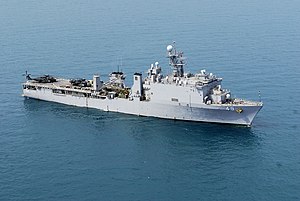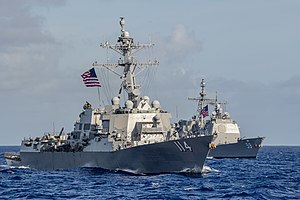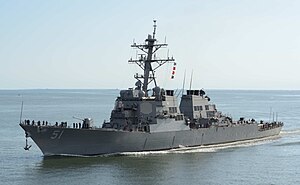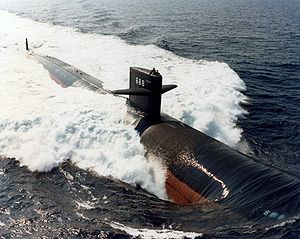Riamese Navy
This article is incomplete because it is pending further input from participants, or it is a work-in-progress by one author. Please comment on this article's talk page to share your input, comments and questions. Note: To contribute to this article, you may need to seek help from the author(s) of this page. |
| Royal Riamese Navy | |
|---|---|
| Founded | 9 June 1719 |
| Website | www.armedforces.gov.ri |
| Personnel | |
| Military age | 18 |
| Industry | |
| Foreign suppliers | |
| Annual exports | |
The Riamese Navy is the naval component of the Riamese Armed Forces. Her duties include protecting Riamese and regional diplomatic, economical, and social interests, as well as providing an offensive and defensive force capable of defending the nation and its peoples.
Role
Functions of the defense force include:
- Defend national interests of Riamo
- Assisting in labors of national security as well as during environmental disasters
- Affirming Riamese position as a leading naval power
- Project a sense of security to the nations with economical, cultural, historical and political ties to Riamo
- Humanitarian Aid and Peacekeeping
Riamo has no separation between navy, coast guard, sea police or anything alike, being the navy the force that encompasses all roles coast guard would also cover in traditional countries.
History
Pre-colonial times
Before the dawn of the Empire the Riamese fleet was mostly composed of smaller trading vessels, with Speer, Butter and Linghtings being common sights. The vast majority of the wartime fleet was not owned by the monarch but rather medieval lords, whose ships would be called to assist the king in case of war but were allowed to operate with normality otherwise.
By the late 14th century, the invention of the Galtiner as an exploration ship allowed Riamese adventurers to start discovering lands far from Metropolitan Riamo, while others like the Portington spread around Guri and the central coast as an efficient armed attack sailing ship.
Empire
By the 16th century, explorers had managed to expand Riamese influence over the waves, with colonies eventually sparkling across and around the Talsar Ocean with massive incentives from the crown. Ships like the Double Galtiner and the Portington were popularized throughout the empire by this time, and would become the backbone of the navy for years to come.
Larger ships like the Tripple would allow for farther exploration by the 17th century, allowing for the colonization of Freice and Gassassinia, among others. It would be variations of the Tripple that helped put Riamese ships at par with the rest of the eastern kingdoms.
Modern Era
Tall masted wooden vessels would soon be phased out for newer ships by the late 19th century, with cruisers being caught first by the wave of armoured shipbuilding. All first Riamese attempts at armoured shipbuilding proved futile, most including some combination of masts and engines with wood and metal while usually including less than half the safe boats needed for embarking their full crews. By the 1880s sails had proved counterproductive when combined with boilers, being phased out in the Riamese and Neuew navies by 1885.
Armoured & Protected Cruisers
Armoured cruisers would appear in the mid 1880s, featuring am armoured belt on the waterline protective against most direct hits to the broadside, but would soon be proven ineffective against the ever-advancing high penetration projectiles that were appearing by the dawn of the 20th century.
They would be closely followed by the protected cruisers, featuring an internal armoured deck that covered the vital parts and citadel at an angle, increasing effectiveness in relation to thickness, some still proving useful by the late 1920s.
The so-called Light Cruisers would be born as lighter versions of Armoured Cruisers. Mostly meant for escort, spotting and patrolling duties, they would soon be popularized. The idea would stay afloat past the Battleship period, with a generational change between the 1920s-30s. By this time, the concept of light cruisers evolved to cover fleet needs and trade protection roles.
Cruisers by the 1930s usually presented a combination of good speed, manoeuvrability, torpedo armament, and plane launching systems, in exchange for lower armour and firepower than Battleships of the era.
| Name | Image | Ships | Notes | |
|---|---|---|---|---|
| Surface Combatants | ||||
| Triumphant Class Amphibious Assault Ships (Landing Helicopter Dock) |
|
|||
| Diana Class Amphibious Assault & Medical Assistance Ship |
|
|||
| Helicopter Carrier (Support and Helicopter Training) |
She was inaugurated by Queen Diana herself as a command & humanitarian aid ship, later being in several natural disasters helping people globally, slowly becoming a national symbol of Riamo amongst its people.
|
Unique merchant conversion, Landing Ship Dock | ||
| Liberty Class Destroyers |
|
Sometimes called "Guri-B Class", the Libertad Class is a never version of the Guri Class with changes in configuration and design. All units but Qazhshavan ones have the Riamese-Vultesian designed Trident Combat System | ||
| Guri Class Destroyers |
|
Sometimes called "Guri-A Class", the Guri Class Destroyers are the first series to include the Riamese-Vultesian designed Trident Combat System | ||
| Albert Jhonson Class Litoral Patrols |
|
|||
| Delta Class Frigates |
|
Mostly used as light coastal patrol | ||
| Thunder Class Litoral Patrols |
Batch 2:
|
Co-developed by Sister of Seabird Class | ||
| Yankee Class Minehunters |
|
Co-developed by | ||
| Monarch Class Corvettes |
|
|||
| Queensboro Class Assault Submarines |
|
|||
| Auxiliary Ships | ||||
| Mercy Class Hospital Ships |
|
|||
| Cape June Class At-sea-replenishment Ships |
|
|||
| Sundancer Class Hidrographic Vessels |
|
|||
| Independence Class Oceanographic Vessel |
|
|||













